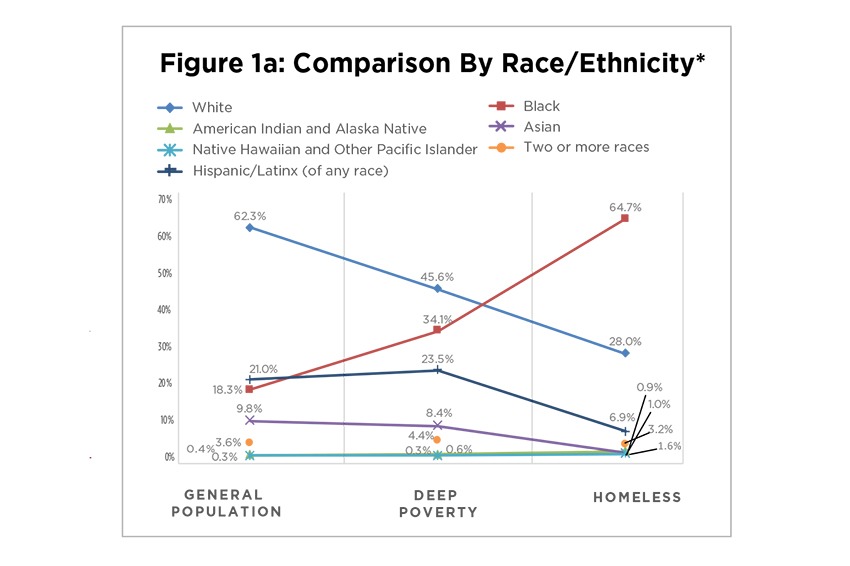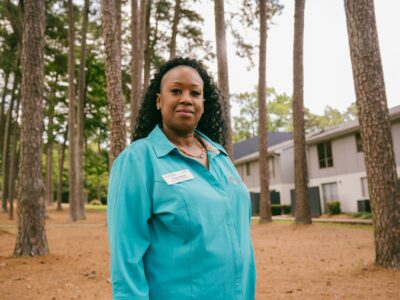Homelessness is a racial justice issue. Research shows that Black and Native Americans experience homelessness at disproportionately high rates, even when we control for disparities in poverty level.
This means that, like so many other systems of care in America impacted by racism, the homeless response system produces racial disparities. The system can maintain or exacerbate these disparities — or work to dismantle them.
We heard from communities in the Built for Zero movement that they wanted to address racial disparities in their homeless systems.
In response, we worked with local homeless services leaders and people who experienced homelessness to develop a framework for understanding and improving the racial equity of a community’s homeless response system.
Our team believes this framework can empower communities working to end homelessness to ensure their systems aren’t leaving anyone behind. This framework is just one tool in the movement toward racial equity, driven by a growing coalition of organizations within the homeless sector.

Why Start with Measurement?
Over the last five years, the Built for Zero movement of communities working to end homelessness has demonstrated the power of shared, transparent measurement. By committing to a community-wide aim of functional zero and tracking monthly progress toward this shared goal, we’ve seen 14 communities end homelessness for one or more populations. Dozens more have achieved significant reductions in veteran or chronic homelessness.
Now, as community teams work to bring greater urgency to understanding and improving the racial equity of their homeless response systems, we believe measurement is key. Measurement allows us to establish a shared aim, catalyze learning, and hold ourselves accountable for progress.
To develop a framework for measuring the racial equity of a community’s homeless response system, our team started with a set of “first principles” that we think any good goal should have. Next, we gathered input from 11 external partners, four Built for Zero community teams, and three focus groups of people with lived experience of homelessness. Then, we distilled this learning into a framework to support communities to measure and design a racially equitable homeless response system.
The framework seeks to equip communities with signals of progress across four critical areas:
- equitable system decision-making power
- lived experience
- quality data
- system outcomes
A Framework for Assessing the Racial Equity of a Homeless Response System
These four indicators are the places our team believes a community should look to evaluate and improve the racial equity of its homeless response system:
1. System decision-making power
Homeless response systems are made up of a constellation of agencies, programs, and service providers working in concert. Due to the nature of this multi-stakeholder ecosystem, practitioners in the field identified system decision-making power (ex: governance, policies and procedures) as essential to ensuring improvements in equitable outcomes and lived experience are sustained over the long-term.
2. Lived experience of homelessness
As with any system of care, the homeless response system’s outcome data only tells us part of the story. Qualitative data around the experiences of people being served by these systems is vital. People with lived experience of homelessness helped us hone in on “timely services that preserve dignity” as a more relevant expression of what is commonly thought of as “customer satisfaction” in other sectors.
3. Quality data
Unpacking system outcomes, and the demographics of people who might be underserved, requires client-level data that is comprehensive and accurately captures how individuals self identify their race and ethnicity. Without establishing quality data first, communities run the risk of analyses that arrive at faulty conclusions. As the old adage goes, “garbage [data] in, garbage [analysis] out.”
4. System outcomes
Quantitative metrics around disparities in outcomes across groups can help us understand who our systems might be failing today. The framework equips communities to track disparities in:
- The length of time people spend homeless
- Rates of return from housing, which tell us about the level of support folks are afforded and the sustainability of our interventions
- Rates of exit to permanent housing, which can help us think about resource allocation and who is being underserved by our current systems of care
Putting it Into Action
Our plan is to start supporting communities with tangible tools to start establishing baselines and driving improvement across these four indicators in the months ahead. We encourage communities to determine whether there are additional locally-salient indicators and measures to incorporate into their work.
While we recognize that this framework is limited in scope, we are confident these indicators give every community a tangible way to deepen their work toward housing justice.
We also know that many of our field’s best insights have come from the concrete experiences of the practitioners and end-users closest to the problem. So as communities begin measuring and improving toward more racially equitable systems, it is likely these indicators will evolve. We will continue to document and share our learning and highlight community bright spots as we move collectively toward a more racially equitable future.






